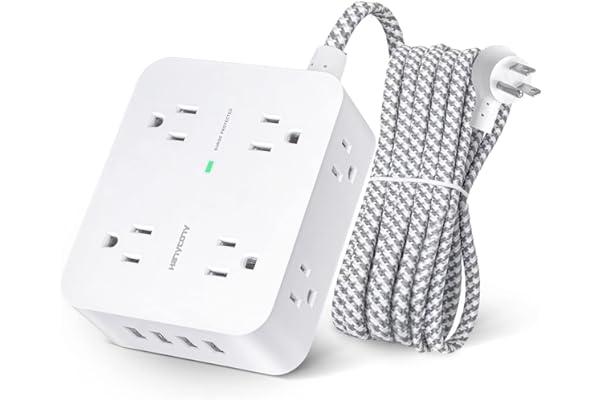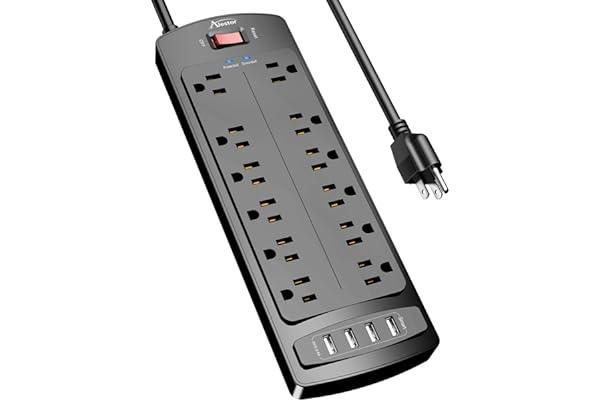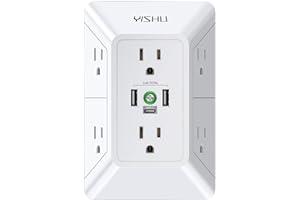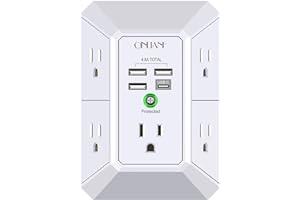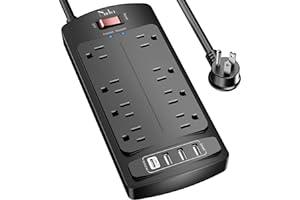Best Selling Power Strips
Power strips are a convenient way to add more outlets to an existing electrical outlet. They can be used to power multiple devices at once, or to extend the reach of an outlet that is in a difficult-to-reach location. Power strips come in a variety of sizes and styles, and some models also include surge protection.
Links to Best Selling Power Strips
- Surge Protector Power Strip - 8 Widely Outlets with 4 USB Charging Ports, 3 Side Outlet Extender with 5Ft Braided Extension Cord, Flat Plug, Wall Mount, Desk USB Charging Station for Home Office ETL (paid link)
- Power Strip, ALESTOR Surge Protector with 12 Outlets and 4 USB Ports, 6 Feet Extension Cord (1875W/15A), 2700 Joules, ETL Listed, Black (paid link)
- Multi Plug Outlet Surge Protector - YISHU 3 Sided Power Strip with 6 AC Outlet Extender and 3 USB Ports (1 USB C), Adapter Spaced Outlet Splitter, ETL Listed, White (paid link)
- Wall Charger, Surge Protector, QINLIANF 5 Outlet Extender with 4 USB Charging Ports (4.8A Total) 3-Sided 1680J Power Strip Multi Plug Adapter Spaced for Home Travel Office (3U1C) (paid link)
- Surge Protector Power Strip - Nuetsa Flat Plug Extension Cord with 8 Outlets and 4 USB Ports, 6 Feet Power Cord (1625W/13A), 2700 Joules, ETL Listed, Black (paid link)
Types of Power Strips
There are two main types of power strips: ungrounded and grounded. Ungrounded power strips are the most common type, and they are typically used for non-essential appliances. Grounded power strips are more expensive, but they offer better protection against electrical surges.
Power strips can also be classified by the number of outlets they have. Single-outlet power strips are the most basic type, and they typically have one or two outlets. Multi-outlet power strips have more outlets, and they can be either ungrounded or grounded.
Some power strips also include other features, such as surge protection, USB charging ports, and a built-in cord organizer. Surge protection is a valuable feature that can protect your devices from damage caused by electrical surges. USB charging ports are convenient for charging mobile devices, and a built-in cord organizer can help to keep your cables tidy.
How to Choose a Power Strip
When choosing a power strip, there are a few factors you should consider:
- The number of outlets you need
- Whether you need grounded or ungrounded protection
- The length of the power cord
- The presence of additional features, such as surge protection, USB charging ports, and a built-in cord organizer
Once you have considered these factors, you can start shopping for a power strip that meets your needs. You can find power strips at most hardware stores and electronics retailers.
How to Use a Power Strip
Using a power strip is simple. Just plug the power strip into an outlet, and then plug your devices into the power strip. Be sure to only plug in as many devices as the power strip is rated for. If you overload a power strip, it could overheat and cause a fire.
Here are a few tips for using a power strip safely:
- Don't overload the power strip.
- Don't plug in wet or damp devices.
- Don't use a power strip if it is damaged.
- Unplug the power strip when you are not using it.
Conclusion
Power strips are a convenient and affordable way to add more outlets to your home or office. They can be used to power multiple devices at once, or to extend the reach of an outlet that is in a difficult-to-reach location. When choosing a power strip, be sure to consider the number of outlets you need, whether you need grounded or ungrounded protection, the length of the power cord, and the presence of additional features.
